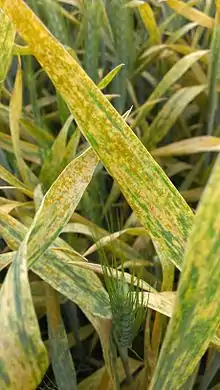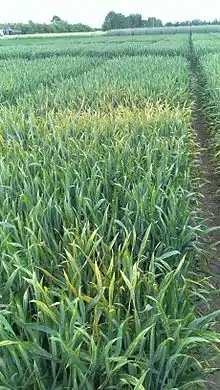Wheat yellow rust
Wheat yellow rust (Puccinia striiformis f.sp. tritici), also known as wheat stripe rust, is one of the three major wheat rust diseases, along with stem rust of wheat (Puccinia graminis f.sp. tritici) and leaf rust (Puccinia triticina f.sp. tritici).
| Wheat yellow rust | |
|---|---|
 | |
| Yellow rust on the leaves of winter triticale | |
| Scientific classification | |
| Kingdom: | |
| Division: | |
| Class: | |
| Subclass: | |
| Order: | |
| Family: | |
| Genus: | |
| Species: | P. striiformis var. tritici |
| Binomial name | |
| Puccinia striiformis var. tritici Westend., (1854) | |
| Synonyms | |
| |

History
As R.P. Singh, J. Huerta-Espino, and A.P. Roelfs say in their (undated) comprehensive review of literature on the wheat rusts for UN FAO:[1]
Although Gadd first described stripe rust of wheat in 1777, it was not until 1896 that Eriksson and Henning (1896) showed that stripe rust resulted from a separate pathogen, which they named P. glumarum. In 1953, Hylander et al. (1953) revived the name P. striiformis.
Symptoms

Yellow rust, or stripe rust, takes its name from the appearance of yellow-colored stripes produced parallel along the venations of each leaf blade. These yellow stripes are actually characteristic of uredinia that produce yellow-colored urediniospores. Primary hosts of yellow rust of wheat are Triticum aestivum (bread wheat), Triticum turgidum (durum wheat), triticale, and a few Hordeum vulgare (barley) cultivars.
Other cereal rust fungi have macrocyclic, heteroecious life cycles, involving five spore stages and two phylogenetically unrelated hosts. The alternate host of stripe rust had been unknown until 2009, when a team of scientists at the USDA-ARS Cereal Disease Lab led by Dr. Yue Jin confirmed that barberry (Berberis spp.) is an alternate host.[2] Barberry was known as an alternate host of the closely related stem rust (Puccinia graminis) and for many years, when infection was observed on barberry, it was assumed to be stem rust.[3] Scientists observed rust infection on various barberry species, and inoculated spores onto grass hosts.[2] Kentucky Bluegrass showed infection characteristic of stripe rust. Later, infected wheat plants bearing teliospores were soaked in water and suspended over barberry species.[2] Infection was produced, thus solving a "century-old mystery" of plant pathology.[2]
The disease usually occurs early in the growth season, when temperature ranges between 2 and 15 °C (36 and 59 °F); but it may occur to a maximum of 23 °C (73 °F). High humidity and rainfall are favorable conditions for increasing the infection on both leaf blade and leaf sheath, even on spikes when in epidemic form. Symptoms are stunted and weakened plants, shriveled grains, fewer spikes, loss in number of grains per spike and grain weight. Losses can be 50%, but in severe situations 100% is vulnerable. Since yellow rust can occur whenever the wheat plants in green and the environmental condition conducive for the spore infection, yellow rust is a severe problem in the wheat-producing regions worldwide. Temperatures during the time of winter wheat emergence and the coldest period of the year are crucial for epidemic development in winter-habit wheat crops.[4]
Worldwide population structure
Both the spatial genetic structure and the spatial dissemination of this disease have been investigated.[5] Population genetic analyses indicate a strong regional heterogeneity in levels of recombination, with clear signatures of recombination in the Himalayan and near-Himalayan regions and a predominant clonal population structure in other regions. The existence of a high genotypic diversity, recombinant population structure, high sexual reproduction ability, and the abundance of the alternate host (Berberis spp.) in the Himalayan and neighboring regions suggest the region as a plausible Pst center of origin or at least very close to its centre of origin. However, further exploration may be useful from Central Asia to East Asian regions.[5]
Disease management
Breeding resistant varieties is the most cost-effective method to control this rust. Fungicides are available but vary in availability depending on their registration restrictions by national or state governments.[6][7] Development of varieties resistant to the disease is always an important objective in wheat breeding programs for crop improvement. This has been done in the past, however as normal, these resistance genes became ineffective due to the acquisition of virulence to that particular resistance gene rendering the variety susceptible - necessitating ongoing variety development.[8]
Resistance genes
These genes are abbreviated Yr and Yr1, Yr24, etc.
References
- Singh, R.P.; Huerta-Espino, J.; Roelfs, A.P. "The wheat rusts". www.fao.org. Retrieved 2018-08-25.
- Jin, Yue; Szabo, Les J.; Carson, Martin (2010-04-07). "Century-Old Mystery of Puccinia striiformis Life History Solved with the Identification of Berberis as an Alternate Host". Phytopathology. 100 (5): 432–435. doi:10.1094/PHYTO-100-5-0432. ISSN 0031-949X. PMID 20373963.
- Stakman, E. C. (1918). The black stem rust and the barberry /. Washington, D.C.: Government Printing Office. doi:10.5962/bhl.title.135472.
- Aslanov, Rufat; Moussa El Jarroudi; Mélanie Gollier; Marine Pallez-Barthel; Marco Beyer (2019-01-04). "Yellow rust does not like cold winters. But how to find out which temperature and time frames could be decisive in vivo?". Journal of Plant Pathology. online first (1): 539–546. doi:10.1007/s42161-018-00233-y. S2CID 91716438.
- Ali, Sajid; Pierre Gladieux; Marc Leconte; Angélique Gautier; Annemarie F. Justesen; Mogens S. Hovmøller; Jérôme Enjalbert; Claude de Vallavieille-Pope (2014-01-23). "Origin, Migration Routes and Worldwide Population Genetic Structure of the Wheat Yellow Rust Pathogen Puccinia striiformis f.sp. tritici". PLOS Pathogens. 10 (1): e1003903. doi:10.1371/journal.ppat.1003903. PMC 3900651. PMID 24465211.
- "Stripe Rust - Washington State University". wsu.edu. Retrieved 2 August 2018.
- http://extension.usu.edu/files/publications/factsheet/wheat-stripe-rust08.pdf
- de Vallavieille-Pope, Claude; Ali, Sajid; Leconte, Marc; Enjalbert, Jérôme; Delos, Marc; Rouzet, Jacques (1 January 2012). "Virulence Dynamics and Regional Structuring of Puccinia striiformis f. sp. tritici in France Between 1984 and 2009". Plant Disease. 96 (1): 131–140. doi:10.1094/pdis-02-11-0078. PMID 30731861.
- Rola El Amil (Lebanese Agricultural Research Institute, Lebanon) (2020-11-09). (DAY 2) - Phytosanitary Safety for Transboundary pest prevention - Yellow and Black rust population variability. CGIAR Germplasm Health Webinar series. Phytosanitary Awareness Week. International Institute of Tropical Agriculture / CGIAR. Slide at 00:44:37.
- Ali S. (2012) Population biology and invasion history of Puccinia striiformis f.sp. tritici at worldwide and local scale, Ph.D. dissertation. Université Paris-Sud 11.
- Chen, X. M. 2005. Epidemiology and control of stripe rust [Puccinia striiformis f. sp. tritici] on wheat. Can. J. Plant Pathol. 27:314-337.
- Doodson, J.K., Manners, J.G. and Myers, A. (1964). Some effects of yellow rust (Puccinia striiformis) on the growth and yield of spring wheat. Ann. Bot. 28: 459-472.
- Eriksson, J. and E. Henning. 1896. Die Getreideroste. Ihre Geschichte und Natur sowie Massregein gegen dieselben. P. A. Norstedt and Soner, Stockholm. 463 pp.
- Hogg, W.H., C.E. Hounam, A.K. Malik, and J.C. Zadoks. 1969. Meteorological factors affecting the epidemiology of wheat rusts. WMO Tech Note 99. 143 pp.
- Hovmøller, M. S., Sørensen, C. K., Walter, S., Justesen, A. F. (2011) Diversity of Puccinia striiformis on cereals and grasses. Annual Review of Phytopathology 49, 197-217.
- Hylander, N., I. Jorstad and J.A. Nannfeldt. 1953. Enumeratio uredionearum Scandinavicarum. Opera Bot. 1:1-102.
- Jin, Y., Szabo, L.J., and Carson, M. 2010. Century-old mystery of Puccinia striiformis life history solved with the identification of Berberis as an alternate host. Phytopathology 100:432-435.
- Poehlman J.M. and D.A. Sleper. 1995. Breeding Field Crops. 4th Ed. Iowa State Press/Ames, Iowa 50014.
- Robbelen, G. and Sharp, E. L., 1978. Mode of inheritance, interaction and application of genes conditioning resistance to yellow rust. Adv. Plant Breeding, 9, 88 pp.
- Saari, E. E. and Prescott, J. M., 1985. World distribution in relation to economic losses. Pages 259-298, in: The Cereal Rusts Vol. II: Diseases, distribution, epidemiology and control, A. P. Roelfs and W. R. Bushnell eds., Academic Press, Orlando, Fl.
- Stubbs, R. W., 1985. Stripe rust. Pages 61–101 in: The Cereal Rusts Vol. II: Diseases, distribution, epidemiology and control, A. P. Roelfs and W. R. Bushnell eds., Academic Press, Orlando, Fl. Zadoks, J. C. and Bouwman, J. J., 1985. Epidemiology in Europe. Pages 329-369 in: The Cereal Rusts Volume II: Diseases, distribution, epidemiology and control, A. P. Roelfs and W. R. Bushnell eds., Academic Press, Orlando, Fl.
External links
- http://www.ars.usda.gov/SP2UserFiles/ad_hoc/36400500Publications/CerealRusts/The%20Cereal%20Rusts_VOLUME%20II.pdf
- http://www.ars.usda.gov/SP2UserFiles/ad_hoc/36400500Cerealrusts/stripe_rust_control.pdf
- http://www.ars.usda.gov/SP2UserFiles/ad_hoc/36400500Cerealrusts/Pst-life-cycle%20Phyto-reprint.pdf
- http://www.cimmyt.org
- http://www.ars.usda.gov/Main/site_main.htm?modecode=36-40-05-00
- "Norwich Rust Group". Norwich Rust Group. Retrieved 2020-12-18.